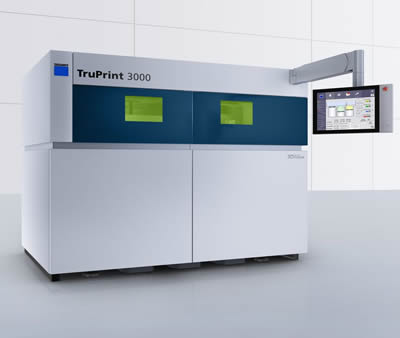
MBFZ toolcraft GmbH reports that 3D printing is developing at an increasingly rapid pace. While plastic parts can already be 3D printed on home printers, metal 3D printing remains in the hands of innovative industrial companies. Here, the transition has already been made from rapid prototyping to rapid manufacturing. Both the ability to produce titanium bone implants and the growing interest in the technology shown by politicians are clear indications that the manufacturing method is ready to be used for series production. To improve its additive manufacturing processes, toolcraft has invested in new laser melting machines from Trumpf.
Metal laser melting can be used to manufacture complex and efficient lightweight structures, as well as internal structures. This means the technology is especially beneficial for the aerospace, energy, medical engineering and motor sports industries. It enables entire processes to be reinvented from scratch and has a host of advantages over conventional production methods. These are especially evident when manufacturing extremely complex parts needed quickly and in small quantities. The technique also allows last-minute design changes to be implemented quickly and easily, and is even capable of producing parts up to 30 percent lighter in weight than conventionally manufactured components. What's more, it can be used to manufacture previously complex groups of components as a single piece following a few small design tweaks. This is not only more cost-effective, but avoids the need for once crucial joining techniques to be applied.
As a pioneer in additive technology with more than 15 years' experience, Trumpf manufactures robust and reliable machines for industrial series production. The company offers both of the laser technologies relevant to additive manufacturing – laser metal fusion and laser metal deposition. In order for the process to be used in an industrial setting, Trumpf provides a comprehensive range of solutions comprising digitisation, machines and services. toolcraft has set up the entire process chain in-house, from design, manufacture and refinement using machining techniques, to quality control and nondestructive testing in accordance with NADCAP requirements.
"We decided to purchase the TruPrint machine in order to spur on developments in the area of additive manufacturing," says Christoph Hauck, managing director of toolcraft. With this endeavour in mind, the company is constructing its own laser melting centre with a production area of 800 m².
"We are delighted at toolcraft's forward-looking decision to implement and help drive forward the use of additive manufacturing in industry by purchasing the TruPrint 3000 with its industrial part and powder management features," comments Daniel Lichtenstein, head of sales and market development at Trumpf's Additive Manufacturing division.
The TruPrint 3000 is used for the series production of complex, metal components. It offers considerable flexibility in terms of the size, number of parts and geometry of the components it is used to produce. The interchangeable cylinder principle reduces set-up times, increases productivity and machine utilisation rate, and ensures a clean, powder-free production run. Meanwhile, additional time is saved thanks to the simultaneous LMF, powder and parts processes. Production is further optimized by intelligent monitoring solutions and consistent software.
Related Glossary Terms
- lapping compound( powder)
lapping compound( powder)
Light, abrasive material used for finishing a surface.
- nondestructive testing ( NDT)
nondestructive testing ( NDT)
Same as nondestructive inspection but implying use of a method in which the part is stimulated and its response measured quantitatively or semiquantitatively.
- quality assurance ( quality control)
quality assurance ( quality control)
Terms denoting a formal program for monitoring product quality. The denotations are the same, but QC typically connotes a more traditional postmachining inspection system, while QA implies a more comprehensive approach, with emphasis on “total quality,” broad quality principles, statistical process control and other statistical methods.
